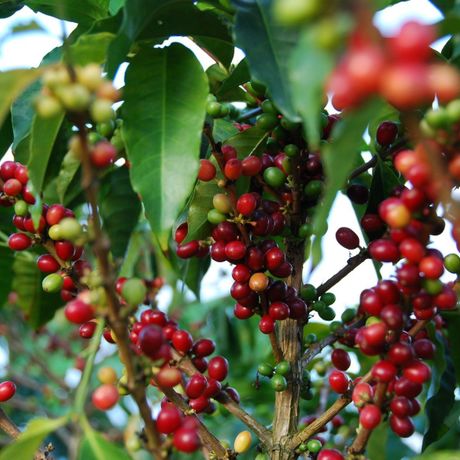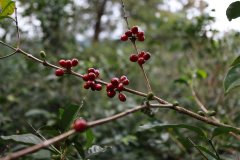Characteristics of three major coffee varieties Arabica, Robusta and Liberka Arabica coffee beans

Professional coffee knowledge exchange More coffee bean information Please pay attention to coffee workshop (Weixin Official Accounts cafe_style)
of Arabica
A brief comparison of the world's three major coffee varieties:
One. Coffee beans can be roughly divided into three types: (1) Arabica coffee tree,(2) Robusta coffee tree and (3). Liberica coffee tree.
Two. Coffee production: Arabica accounts for 69% of world coffee production, Robusta accounts for 30% of world coffee production, Liberica accounts for about 1% of world coffee production. Therefore, coffee beans and coffee futures trading in the world are mainly Arabica and Robusta.
Three. Arabica/Robusta fundamental comparison:
Characteristics/Varieties
Arabica
Robusta
Place of origin, growing environment
It is the most popular coffee bean in the market. It is mainly grown in the plateau areas of the Western Hemisphere, including Brazil, Colombia and other Latin American countries. Brazil and Colombia are the world's first and second largest coffee producers respectively. They grow at heights of more than 2000 feet and have moderate and stable temperatures.
It is mainly grown in low-lying and hot Africa and Asia, with Cote d'Ivoire being the most important producer, Uganda followed by Indonesia, Vietnam, Thailand, India, etc., and heights ranging from 500 to 2000 feet, with strong disease resistance.
Harvest time and yield
Arabica coffee trees take five years to bear fruit from seedlings, with the main harvest period being May-September in Brazil and April-June in Colombia, accounting for about 70 percent of the global market.
Robasta coffee trees only need two to three years to bear fruit, Indonesia harvest every year from April to August, Vietnam every year from October to April of the following year, the total production accounts for about 30% of the global market.
Features and uses
Mild taste, aroma and wine sour, high quality, relatively high price.
It has strong resistance to pests and diseases, less popular taste and aroma, and is mainly used as a blend and as a raw material for instant coffee.
Arabica vs Robusta The difference between Arabica and Robusta coffee:
Coffee beans are seeds belonging to the Rubiaceae family, under which there are at least 25 main varieties of Coffee Genus, of which the two most important varieties are Arabica species Coffee arabica (Arabica coffee) and Canafora species Coffee canephora (Robusta coffee), also known as "Robasta coffee". Arabica coffee beans account for 70% of global production, and robasta coffee beans account for about 30%. Arabica coffee has 44 chromosomes, while robasta coffee has 22 chromosomes, so Arabica coffee is a crop that cannot be crossed with robasta coffee.
Coffee trees are affected by climate, altitude, soil quality and other factors in different regions, which affect the quality and flavor of coffee beans, just like other agricultural products such as tea and wine. Therefore, even if they come from the same country, different regions have different flavors, and the prices naturally vary. Coffee trees belong to evergreen plants, cultivated in tropical and subtropical areas, the most suitable growth conditions are, to have a proper amount of rain, soil drainage is good, so more choose in rich volcanic ash (rich in organic matter) inclined slope, and therefore most of the high-quality Arabica coffee beans are manually harvested and then carried down by horses or mules.
Arabica coffee beans smaller, obverse for the long oval, the middle of the split line crack narrow and tortuous, S-shaped, beans on the back of the arc shape is more complete. Robasta coffee beans are larger in shape, tend to be round on the front, and split cracks in the middle into straight lines. (VivOlé Arabica beans in the following pictures are Maragogype beans, higher grades and larger beans)
In terms of cultivation, robasta coffee trees can withstand high temperature, cold, drought, moisture, pest resistance and strong adaptability characteristics, in the flat can grow very well, unfortunately the coffee beans produced, lack of aroma, bitter (caffeine), acidity is not enough, so more used for instant coffee, canned coffee, or brewing three-in-one coffee. In Italy, many coffee shops add the appropriate proportion of Robusta beans to espresso coffee to deepen the "taste"(such as strong, rough, etc.).
The difference between Arabica coffee and Robasta coffee, which is generally used for canned drinks, is as follows:
Arabica
Robusta
chromosome
44
22
From planting to first harvest
4-5 years
2-3 years
flowering to bear red fruit
9 months
10 to 11 months
ripe fruit
dropped
Stay on the branch.
Wild tree species highest
7 - 12 m
10 meters
root
deep earth
shallow soil
optimal growth temperature
15 -24℃
24 -30℃
optimum rainfall
1500 -2000 mm
2000 -3000 mm
optimum growth height
900 - 2000 m
0 - 700 m
growth environment
Warm and cool
warm and humid
Number of coffee beans produced by coffee trees
low
high
Share of global production
Approximately 70%
Approximately 30%
planting
Mostly organic.
Commercial large-scale cultivation
planting land
Mostly private farms.
Mostly controlled by multinational corporations
Coffee bean harvesting
artificial
vibrating machine
disease resistance
weak
strong
insect resistance
weak
strong
caffeine
1.1-1.7%
4.5-4.7%
result characteristic
monogamy
heterogamy
fruit color
yellow or red
dark red
bean form
Long oval, flat
Elliptical, spherical
bean line
S-shaped
linearly
post-cooking characteristics
acid
bitter
Density (BODY)
Average 1.2%
Average 2.0%
Flavor (FLAVOR)
Jia
difference
Quality vs. Quantity
Arabica coffee represented quality, while robasta coffee represented quantity.
How to distinguish Arabica coffee beans from Robusta coffee beans:
Arabica coffee beans are oblong and flat in shape.
Robusta coffee beans are oval, spherical or nearly spherical in shape.
* Countries or regions where coffee is produced:
Coffee is produced in about 60 countries around the world, and the main coffee producing areas are distributed in the loop of the Tropic of Cancer, which is also known as the Coffee Zone or Coffee Belt.
The most important areas include Central and South America, Africa, Asia, the southern Arabian Peninsula and Oceania.
These areas have one thing in common: temperature, annual rainfall are roughly the same, and there is plenty of sunshine and fertile soil.
Among the many varieties of Arabica, the most famous and distinctive coffee varieties are Typic and Bourbon. Bourbon is more resistant to high temperatures than Typic and is better suited to lower altitudes.
Arabica Coffee Bean Features-Why is only Arabica often used to make specialty coffee?
Important Notice :
前街咖啡 FrontStreet Coffee has moved to new addredd:
FrontStreet Coffee Address: 315,Donghua East Road,GuangZhou
Tel:020 38364473
- Prev

Yunnan Coffee you do not know the secret where is the development of Yunnan small-grain coffee brand?
Professional coffee knowledge exchange more coffee bean information please pay attention to the coffee workshop (Wechat official account cafe_style) how to brew Yunnan small coffee in China, it is not difficult to have a cup of Yunnan coffee, because 99% of the domestic coffee comes from Yunnan, Yunnan is the largest Arabica coffee growing area in China, as well as Panzhihua in Sichuan, Leizhou Peninsula in Guangdong, Fujian, Guangxi and Hai.
- Next

How to distinguish between Robusta and Arabica? In which country did Arabica come from?
Professional coffee knowledge exchange more coffee bean information Please pay attention to the coffee workshop (Wechat official account cafe_style) Arabica from the appearance, Arabica bean body is longer and flat, the central line is S-curve, Robbins Tadou is strong, the shape is also more round, the central line is closer to a straight line. If you want to understand coffee, you must start with coffee beans. There are about three kinds of coffee in the world.
Related
- Detailed explanation of Jadeite planting Land in Panamanian Jadeite Manor introduction to the grading system of Jadeite competitive bidding, Red bid, Green bid and Rose Summer
- Story of Coffee planting in Brenka region of Costa Rica Stonehenge Manor anaerobic heavy honey treatment of flavor mouth
- What's on the barrel of Blue Mountain Coffee beans?
- Can American coffee also pull flowers? How to use hot American style to pull out a good-looking pattern?
- Can you make a cold extract with coffee beans? What is the right proportion for cold-extracted coffee formula?
- Indonesian PWN Gold Mandrine Coffee Origin Features Flavor How to Chong? Mandolin coffee is American.
- A brief introduction to the flavor characteristics of Brazilian yellow bourbon coffee beans
- What is the effect of different water quality on the flavor of cold-extracted coffee? What kind of water is best for brewing coffee?
- Why do you think of Rose Summer whenever you mention Panamanian coffee?
- Introduction to the characteristics of authentic blue mountain coffee bean producing areas? What is the CIB Coffee Authority in Jamaica?

